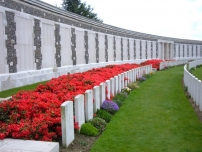| First Name: | Leonard | Last Name: | JANES | |
|---|---|---|---|---|
| Date of Death: | 30/10/1917 | Lived/Born In: | Kingsland | |
| Rank: | Rifleman | Unit: | London2/8 | |
| Memorial Site: | Tyne Cot Memorial, Belgium | |||
Current Information:Born-Islington
Third Battle of Ypres This was a campaign fought between July and November 1917 and is often referred to as the Battle of Passchendaele, a village to the north-east of Ypres which was finally captured in November. It was an attempt by the British to break out of the Ypres salient and capture the higher ground to the south and the east from which the enemy had been able to dominate the salient. It began well but two important factors weighed against them. First was the weather. The summer of 1917 turned out to be one of the the wettest on record and soon the battlefield was reduced to a morass of mud which made progress very difficult, if not impossible in places. The second was the defensive arrangements of concrete blockhouses and machine gun posts providing inter-locking fire that the Germans had constructed and which were extremely difficult and costly to counter. For four months this epic struggle continued by the end of which the salient had been greatly expanded in size but the vital break out had not been achieved. The Second Battle of Passchendaele. 26 October, 1917–10th November, 1917 Although all the fighting during Third Ypres is often referred to as the Battle of Passchendaele, that name officially belongs to two battles fought late in the campaign. The second of these, the final battle of the campaign, was fought between 26th October and 10th November, 1917, when Canadian and British troops of Second Army attacked the Passchendaele ridge, capture of which would have given them sight of the important railway junction at Roulers, a vital part of the German supply network. At the same time, units from Fifth Army attacked further north. The battle was a success inasmuch as the high ground along the Passchendaele-Westrozebeke ridge ended up in British hands but once again the casualty rate was very high. At this stage and much to Field Marshall Haig’s chagrin, some British divisions were withdrawn from Flanders and sent to Italy to assist the Italian Army after their defeat at the Battle of Caporetto, while others were removed to take part in the forthcoming offensive at Cambrai. As a result of this the whole campaign of 3rd Ypres was terminated. On 30th October, after a five day wait, the second phase of the battle took place. On this occasion 58th Division supported the main attack of the Canadians on Passchendaele Ridge by attacking Moray House, Papa Farm, Hinton Farm and Cameron Houses, German strongpoints lying between Poelcapelle and Passchendaele with their final objective being Noble Farm and the pillboxes south-east of it For this operation 174 Brigade used the 2/8th London battalion with a company of 2/6th London attached. The conditions were truly awful. Men sunk to their armpits in mud. In one instance, four men with ropes tried for two hours to extricate a comrade but failed to do so and his subsequent death by slowly drowning in mud does not bear thinking about. To make matters worse, they soon lost their protective artillery barrage and support failed to materialise on their right so it is not surprising that the new line they established was only one hundred yards in front of the old one. Here they established outposts but that night these forward positions were evacuated. 2/8th London had sustained very heavy casualties of over two hundred and forty most of whom were believed to be killed or drowned. One of these was Leonard Janes. |
||||
| « Back to Search Results | ||||
| If you think any of the information shown here is incorrect, Click Here to submit your amends and comments | ||||




